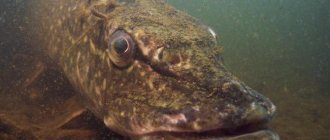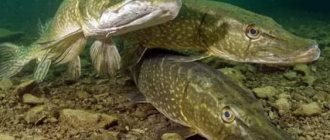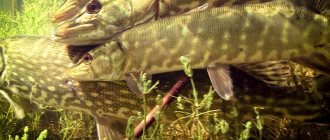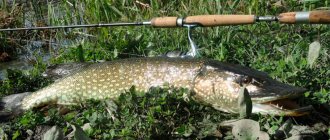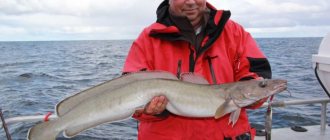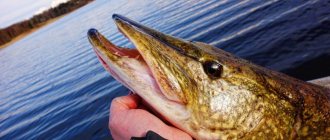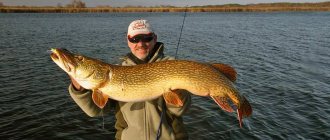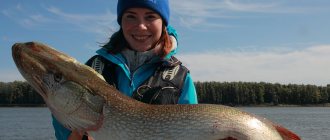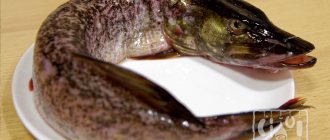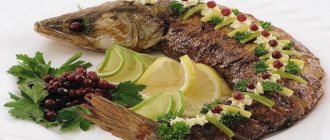Pike is the most famous and popular predator fish living in freshwater bodies of Eurasia and North America. Pike leads a solitary lifestyle, living in the coastal zone, in thickets of aquatic plants in rivers and lakes. Pike belongs to the pike family, the genus pike. The genus Pike includes five species of fish, three of which (Redfin pike, Black pike, Muskiong pike) are found only in North America and two species, Common pike and Amur pike, are found in our country. Pike is a very popular fish among anglers, especially among spinning anglers.
Appearance
Pike body
The pike has a torpedo-shaped elongated body, with fins shifted towards the tail. The whole appearance of the pike speaks of its ability to develop high speed with lightning speed.
Pike fins have a rounded shape, their whole appearance speaks of the excellent hydrodynamic properties of the pike. A long body with large dorsal and anal fins and a muscular tail give the pike the ability to move quickly. True, it can only pursue its prey in short bursts.
The pike has a large, elongated head, a wide mouth, and the lower jaw protrudes slightly forward.
The pike's snout is wide and elongated, somewhat reminiscent of the muzzle of a crocodile. The pike's mouth has a large gripping area; the gill membranes are separated from each other, allowing the pike to open its mouth very wide. Thanks to this, the pike can swallow food of large sizes, up to 2/3 of its own length. Fishermen know this feature of pike, so they often use large baits when fishing for pike.
The entire body of the pike is covered with small scales closely adjacent to each other, which form a dense monolithic cover that reliably protects the body of the pike from the teeth of other pikes.
Body coloring
Pike differ greatly from each other in color. The color can be very different and depends on the age of the pike, the aquatic environment, food supply and other environmental conditions.
The main color of pike scales is gray-green; spots of different shades from yellowish and olive to brown are scattered on a gray background. The spots form transverse stripes on the sides of the pike. The back of the pike is dark, the belly is light yellow or grayish-white.
The coloring of pike has an important camouflage function. A camouflage pattern of transverse stripes and spots scattered throughout the pike’s body makes the pike invisible in the pond. The camouflage pattern on the pike’s body is especially effective in areas with dense vegetation and snags.
The color depends on the age of the pike: young pikes have a lighter color, adults have a darker body color.
The color of pikes greatly depends on their habitat. Pike living in peat and silted reservoirs have a dark body color. Pike living in reservoirs with clear water and a sandy bottom are light in color. Pike living among underwater vegetation, the so-called grass fish, have a greenish body color.
The paired fins of pike are orange or red, the unpaired fins are yellowish-brown, brown or gray with light streaks and stripes.
Females and males of pike do not differ in body color. The female differs from the male in the larger size and shape of the urogenital opening. The urogenital opening of a female pike is an oval depression surrounded by a pink ridge, and in males it looks like a narrow oblong slit.
Mouth, vision, sense organs
The pike has good eyesight, its wedge-shaped snout is designed in such a way that the high-set eyes of the pike allow it to see very well what is in front of it, above it, on the sides of it and even just below it if the object is slightly ahead.
The wide mouth prevents the pike from seeing objects that are below it at a close distance.
Pike have binocular vision and can well determine the distance to moving objects and the speed of their movement. Scientists' experiments show that pike can distinguish more than 20 color shades.
Pike has a well-developed olfactory apparatus, thanks to which at certain periods it can feed on carrion from the bottom of the reservoir.
The pike has a well-developed lateral line organ. Thanks to this organ, pike can hunt even in muddy water and detect the source of the slightest fluctuations in water from a great distance.
Experiments show that even a completely blind pike can successfully obtain food for many years, precisely thanks to the lateral line organ.
Predator teeth and their replacement
The pike's huge mouth is lined with sharp teeth. All pike teeth are not used for chewing food, but for capturing and killing prey. Some of the teeth are located on the jaws; they look like sharp fangs of different sizes, located at some distance from each other.
In addition to the fangs, on the jaws, palate, tongue and cheeks of the pike there are bristle teeth that resemble the bristles of a toothbrush in appearance. The bristle teeth are directed with their sharp ends towards the pharynx and in the normal state are immersed in the mucous membrane. These teeth help the pike hold on and make it easier to swallow prey. When the prey tries to escape from the mouth, the bristle teeth rest against it with their tips and do not allow it to slip out, pushing the prey further into the throat.
There is a legend among fishermen that after spawning and during the full moon, the pike’s teeth change and because of this it stops feeding and is not caught at this time.
In fact, the change of teeth in pike is a continuous process that occurs constantly throughout the life of the pike. The change of teeth in pike has no connection with spawning and the full moon. The passivity of pike and the lack of biting is not associated with a change of teeth, but is explained by a loss of strength due to spawning.
Each tooth in the lower jaw of a pike is adjacent to 2-4 replacement teeth, which are hidden under the soft tissue of the inner surface of the jaw. The active tooth and its replacement teeth together form a dental family. When a pike's working tooth goes out of use, its place is taken by a replacement tooth; at first it is soft and not very stable, but then its base grows to the pike's jaw and becomes strong.
You may be interested in: DaMiKi Pirami 55S. Scout hero.
The change of teeth does not occur simultaneously in pike. If you examine the teeth of a caught pike, you will see old, dissolving teeth, strong working teeth, and new, still mobile, young teeth.
The sharp teeth of a pike can cause a lot of trouble for inexperienced fishermen who have not yet learned how to properly handle the caught fish. Even a scratch from the small teeth of a small pike is very painful and does not heal for a long time. In addition to the teeth, the sharp edges of the pike's gill covers, which can easily cut oneself, pose a danger to the fisherman.
You need to remove the caught pike from the water with a special landing net. Before handling a pike, it is advisable to wear gloves with a protective coating. To remove the bait from the pike's mouth, its mouth is securely fixed with a gaper, and the bait itself is removed with an extractor, while the pike's head is carefully held with one hand under the gills, pressing it against a hard surface.
Fresh water shark - pike
9864
This fish is not found only in mountain, rapidly flowing rivers. It is known everywhere and is very popular, it lives in almost any body of water in the northern hemisphere, both in Eurasia and in America - in the basins of rivers and lakes of the Azov, Aral, Black, Caspian, Baltic Seas and the Arctic Ocean, even in the far north it comes across - in Kamchatka and Anadyr. All five species of pike are freshwater fish.
How big can a pike grow? There are many opinions and assumptions on this topic, most of which have no evidence base. A fisherman talking about his catch will not be able to spread his arms to the sides to the size of the growth of this fish. In fact, the same scheme works in any body of water: if the average size of all fish is large, then the pike will be large, if the fish are small, then there are few food resources, and the pike will also stop growing. This indicator depends on the food supply. It is she who determines the growth factors for predatory fish. It is believed that pike can reach up to two meters in length and weigh more than forty kilograms under favorable environmental conditions. She lives on average thirty years, if the fishermen don’t catch her.
This predator in Russia does not grow so rapidly from the very beginning: in the first three years it gains only one kilogram, but then it adds a kilogram every year. And in Siberia, for example, almost everywhere it grows twice as fast. This is the most agile predator of all the fish in our waters. One has only to look at it: everything speaks of the swiftness of the attack on prey: the head is flattened, long, the mouth is huge and the teeth are in three rows. It is necessary to talk about pike teeth separately and in detail.
They grow towards the throat, and therefore the caught prey can no longer slip back. Teeth grow everywhere: between the jaws, on the palate, at the gill arches, on the lower jaw, and on the tongue. They can fold and hide in the mucous membrane in the mouth due to the fact that the roots fuse with the bone movably. If one of the teeth breaks and falls out, the pike will immediately have a new tooth in the same place - from the spare ones. If the prey is large and strong, the pike still won’t let it go, raising in its mouth all the sharp, needle-like teeth it had previously stored in reserve.
Also, the shape of the body suggests that the pike is an excellent hunter. It is built like a submarine - cylindrical, and is also covered not only with scales, but also with mucus, which greatly helps speed. The fins, shifted to the back of the body, also add to the speed of the throw. Her eyes are located at the top, so she better sees the space above her, in front of her and on the sides. The torpedo-shaped shape during an attack allows you to develop a throw at a speed of more than ten kilometers per hour, which is faster than frightened roach or even perches can rush in all directions.
Pike can hunt in different ways, both from ambush and while swimming. In any case, the color helps her - it is gray-green and speckled, real camouflage. The brightness of the color depends on the type of vegetation of a given reservoir and partly on age: pike are lighter, mature pike are darker. It must be said that predators are voracious, and they feed mainly on fish, so the ability to hide, as well as hunting skills, is vital.
She cannot stand hunger; she calmly eats even small squinting animals (scientists say that this part of the diet makes up up to twenty percent). Pike can really eat everything except vegetation. Frogs, lizards, snakes, that is, amphibians and reptiles, large insects, small mammals - everything goes into the mouth. It is better for mice and moles not to fall into the water. There is also always a danger to the lives of waterfowl and their chicks. Any living creature that reaches up to half the size of this freshwater predator is attacked.
3439
Pike become sexually mature at three or four years of age, and then they go to their first spawning. It occurs in very early spring, when the ice has not yet completely melted in the reservoir, and the water temperature has not risen above four degrees. It’s a little cold, of course, but there are many more advantages to such early spawning. Other fish capable of eating pike eggs have not yet fully woken up, and when small pike fish appear, they will have enough food, but they will have to seriously learn to hunt: by this moment the peaceful fish will have spawned and larvae and fry will appear from their eggs. This is how growing pike become fish-eating predators.
In cold Siberia, pike go to spawn later - at the beginning of May or at the end of April, depending on what the weather is like. In addition, pike do not migrate to spawn if the atmospheric pressure is not stable enough; when it jumps, the fish wait for the end of such unfavorable conditions. Spawning occurs in dense thickets, where leaves and trunks serve for laying eggs, and the pike does not care whether the plant is dead or alive. A school of pike fulfills certain conditions during spawning: first, young, small representatives spawn, then those that are larger, and finally the seasoned ones. Each female is accompanied by males - there are several of them.
The school does not stand in one place; pikes move all the time, covering the bottom and last year’s algae with eggs. After this procedure is completed, all the fish rush headlong in different directions, and with this splash they show the fishermen how many of them there are in this reservoir. After one and a half to two weeks, larvae appear, which will settle in the area chosen by the parents for a very long time, since the fry have enough food. If spawning took place in flooded meadows or in small low-water lakes, which happens very often among pikes, the fry die in huge numbers due to the freezing and then drying out of these reservoirs.
Small pike from one and a half to seven centimeters in length feed mainly on crustaceans - copepods, as a rule. And already in June their diet changes - fry of other fish appear. If possible, young pike migrate to shallow water, and there, in their new habitat, real dangers await them: here, within the borders of coastal algae, older pikes hunt, and together with one-year-old chebak and perch, they will easily eat a small pike. And in deep water there are large pikes, looking out for very large fish.
If in a given reservoir any niche of the food chain is empty, the pike does not receive a complete diet for the necessary development. Then it slows down its growth, and can even stop it completely. Catching small fish requires energy expenditure that is not comparable to the amount of nutrients received. She catches and catches, she gets tired, she catches it and doesn’t notice what she swallowed or whether she swallowed it at all. The pike doesn't eat enough. That's why it doesn't grow. It hunts almost all day and almost everything that moves, but it is of very little use in a reservoir that is poor in living creatures. And the smaller the pike, the more often it needs to dine. She usually needs to eat three to four times a day. But if she managed to grow, her diet changes. For a pike weighing about ten kilograms, it is enough to catch a large fish or waterfowl twice a week.
Young pike quite often hunt in small schools, but an adult is always a lone invader, hiding in ambush, patient and merciless. If the prey does not swim to the ambush site for a long time, the hunter begins to walk around the territory and then the victim cannot hide. This fish not only has excellent eyesight. Poor crucian carp bury themselves in the silt and try not to breathe, much less move, because the pike has strong seismic sensory orientation, plus an excellent perception of chemical odors. If the water is dark and vision cannot be used, the pike will still smell the prey: on its lateral line there are special organs for this.
Adult pike always divide territories and will not covet someone else’s hunting area. If the fish is a little more than a kilogram, it is supposed to have an area of about thirty square meters, and a large, “fairway” pike hunts in an area of seventy to one hundred square meters. A large pike may not stand on ceremony and squeeze out a smaller one. The hunting area may become vacant for other reasons: it was caught by a fisherman, for example. Sometimes, after a successful hunt, a large pike rests for several days and digests its prey in the thickets, and therefore allows one of its relatives to hunt on its grounds.
The pike swallows any prey from the head, even if it is grabbed across the body, managing to work its jaws in such a way that the caught fish turns in its mouth. The gill membranes of pike do not grow into the space between the gills, they do not grow together, which is why this fish can open its mouth as wide as no one else can in principle. Any prey is easily swallowed, even those with a body taller than a pike. The pike can digest large fish for about a week, but most often it does not stop hunting until its stomach is filled to capacity.
Pike usually do not live in cold mountain rivers with a rocky bottom, and they also do not like strong currents. Their environment is flowing lakes, calm rivers, so that the banks are grassy, there are thickets of reeds, channels, branches, bays - this is the kind of terrain this fish likes. If the pond is deep enough and does not freeze completely in winter, if the swamp does not freeze due to springs giving rise to rivers, pike can be found in such places. This fish is considered sedentary, gets used to its “home” under a snag or in the reeds, and in places with fast currents or in shallow water, not a single fisherman will catch pike. Only during spawning does it leave its native places. And it always comes back.
Text: Lyudmila Garkavaya
Tags: fish pike pike-shaped
Age and size of pike
The size and weight of large pikes are legendary. Leonid Sabaneev mentions the legendary pike caught in 1497 in Germany; the ring of the Holy Roman Emperor Frederick II, marked 1230, was found on the pike. Thus, according to this legend, the fish was 267 years old, weighed 140 kg and had a length of 5.7 meters. The spine of this legendary pike was transferred for safekeeping to the cathedral of the German city of Mannheim. Scientists examined this spine and found that it was just a hoax; the spine was assembled from the vertebrae of several individual pikes.
The history of Tsar Boris Fedorovich’s pike is known. Legend has it that in 1794, while cleaning the Tsaritsinsky ponds, a pike with a ring on the gill cover was caught. The inscription “Planted by Tsar Boris Fedorovich” was engraved on the ring. Thus, it turned out that the caught pike was more than 200 years old. This whole story is nothing more than a legend; no documentary evidence of this story has been preserved.
According to legends that have come down to us, pike weighing 56 kg were caught in the Ural lakes, a pike weighing 64 kg was caught in Lake Onega, and a specimen weighing 80 kg was caught in the Vychegda River.
The maximum size of pike reaches, apparently, 1.6 - 1.9 meters, maximum weight 26-35 kg, this is indicated by documented data on the industrial catch of pike.
In order to grow to a weight of 20 kg, a pike must live more than 30 years. It is possible that such huge pikes are still preserved somewhere.
The largest pikes live in wild northern rivers, rarely visited by people; in such places, predators can live to a very old age.
Most often, anglers catch pike with a maximum length of 50 - 70 cm, weighing 1.2 - 3 kg. Pike weighing from 3 to 7 kg are considered large these days. Specimens weighing more than 8 kg are already considered trophy; many fishermen have never managed to catch a fish of this size in their entire lives.
There are legends that pike can live up to 100 years, but these are just legends, the average life expectancy of pike is 18-20 years, under ideal conditions pike can live up to 30 years. But pike, as a rule, do not live to this age, due to catch by fishermen, death in winter from lack of oxygen in the water and freezing of reservoirs to the bottom in especially cold winters.
Where does pike live?
Pike is distributed throughout almost the entire territory of Russia and neighboring countries, with the exception of the regions of the Far North. Pike is undemanding to living conditions and can live in almost any body of water: large and small rivers, lakes, reservoirs, ponds and flooded quarries. Pike can survive in almost any body of water, as long as it does not freeze to the bottom in winter and is supplied with fresh, oxygen-rich water from a spring, stream or river.
Pike tolerates brackish water well and can live in desalinated parts of the seas; in the Baltic Sea, pike is found in the Gulf of Finland, Riga and Curonian Gulfs; in the Sea of Azov, pike is found in the Taganrog Bay. There are also references to pike fishing in the Black, Aral and Caspian Seas.
Sometimes pike are found in bodies of water that have no connection with rivers and lakes. Pike eggs are brought into such reservoirs by waterfowl; there is a theory that fertilized pike eggs pass through the stomach of waterfowl without losing their properties.
Pike does not like fast currents and prefers to stay in quiet places.
Until a certain age, pike tries to stay in the coastal zone, in the grass, in snags. Reaching large sizes and a weight of 3-4 kg, the pike moves deeper into the pits.
Fishermen even conditionally divide pike into two subspecies:
- grass pike, a small fish that lives in the coastal zone, near grass and snags;
- deep-sea pike, a fish of large size and weight hiding in the depths.
How does it reproduce
In the third year of life, young pike, if there is good nutrition, can spawn; males must reach five years. The process occurs in early spring, at the end of March or beginning of April, the main condition is the absence of ice in the coastal zone, the water temperature warmed up to +4 - +7 degrees. The first zhor precedes spawning and the predator, gaining strength, absorbs all living organisms that it can cope with. Gathering in groups of 4-9 individuals, depending on the size of the pike (1:3 or 1:8, female-male, respectively), they swim into shallow water and spawn over a three-week period, for one individual this takes 2-3 days.
Reproduction in natural conditions occurs earlier than in other fish and coincides with the migration of waterfowl, both circumstances affect the survival of eggs. On the one hand, the bee-eaters have time to grow a little and not become food for others, on the other hand, when the eggs fall on a bird’s feather, they are transferred to other bodies of water or die. Not very sticky eggs quickly roll off the surface of plants to the bottom of a pond or lake and become prey for perch, adult relatives, aquatic mammals and larvae. This is how nature controls the population size in natural conditions.
Pike spawns only once a year, the number of spawned eggs is 18-220 thousand, a one-kilogram female is able to lay 50,000 eggs.
What does pike eat?
Pike is a predatory fish that feeds on a wide variety of animal foods. The basis of the pike diet is all kinds of fish. Already, pike fry, whose size barely reaches 1.5 cm and the basis of their diet is zooplankton, are trying to hunt the larvae of various small fish. Having reached a size of 5 cm, pike completely switch to feeding on fish.
Pike are not particularly picky about their diet; they eat whatever they can catch. Among the fish, pike prefer: crucian carp, roach, bream, silver bream, perch, goby, whitefish, bream, roach, ruffe, gudgeon, char, and minnow.
You may be interested in: Sterlet
Pike treats ruffs, perches and pike perch with caution, which have sharp fins and can injure the pike with them. Pike does not really like burbot and tench because of their unpleasant mucus. Having caught a ruff or perch, the pike squeezes it with its jaws for a long time until it feels that its victim has completely stopped resisting and only then swallows it.
Pike often eat other pike if they are smaller in size. Anglers often catch large pike weighing up to 4 kg, with lacerations on their sides. Such wounds indicate that there are even larger pikes in the reservoir, and the caught pike became a victim of their attack. A pike weighing 15 kg, which is 20-25 years old, can eat another pike weighing 8 kg.
In spring and the first half of summer, pike happily eat frogs and molting crayfish. In autumn, during migration, various rodents (mice, rats and squirrels) swim across rivers and often become prey for large pikes. A large pike can grab and drag a duckling, and sometimes even an adult duck, under water, especially during molting, when the duck has difficulty rising into the air. Cases are mentioned when pikes even grabbed geese.
The gluttony of the pike is evidenced by the fact that it is able to swallow food reaching a size of 50-65% of its own weight and size.
Having caught the prey, the pike turns it head first and then swallows it; if the pike cannot swallow its prey completely, it waits until the swallowed part of the prey is digested and then swallows the rest of the prey.
Food in the stomach of pikes is digested very slowly, which is why pikes are so voracious, they have to fill their digestive tract completely to capacity. The pike regurgitates scales and other solid undigested food debris.
Pike feed irregularly; after eating, the pike can digest food for several days and not hunt during this entire time.
The time when pike are actively feeding is commonly called zhor by fishermen. There are three periods of pike feeding: pre-spawning feeding occurs in early spring, post-spawning feeding occurs in April-May, and autumn feeding occurs in the fall with cooling temperatures.
The time of active feeding can be determined by the behavior of the pike. During zhora, the pike often jumps out of the water and starts a fry fight, during which the fry jumps out of the water in different directions. It happens that, carried away by the pursuit of a fry, a pike even jumps out onto the shore during a feast.
Pike fish - brief description and features
Pike is a predator, belongs to the phylum chordata, class ray-finned, pike-shaped, genus pike (lat. Esox).
The length of an individual is usually approximately 1 meter with an average weight of 8 kilos.
Some specimens reach 180 cm and weigh 35 kilos, and females are always larger in size than males.
The body is elongated, in the shape of a long arrow.
The pike head is long, with a narrow snout, and the jaw protrudes from below.
The predator is distinguished by a unique mouth structure, due to which it is called a “river shark”.
Fishing is important for commercial fisheries.
Predator habitat
Individuals live in fresh water in Europe, Asia and North America, and love stagnant bodies of water.
The predator can be found in the Gulf of Finland and Riga in the Baltic Sea; it thrives in the Gulf of Azov.
In ponds and lakes, pike do not swim far from the shore and sit in shallow water, among aquatic debris and vegetation.
In the river, individuals can be seen both at depth and near the shore.
The fish lives exclusively in water with a high level of oxygen. If the river is not saturated with oxygen in winter, the pike may die.
What does pike eat?
In the spring, after starvation in winter, the fish begins to eat everything and can hunt for a long time until it catches up with “dinner”.
It hunts and eats until it is satisfied, until the tail of the next prey is visible from the mouth.
The fish is very voracious and can even feast on other pike.
The main diet of fish consists of:
- Roach.
- Carp.
- Podleschik.
- Gudgeon.
- Crucian carp.
- Shirokolobka.
- Minnow.
- Whiskered loach.
- Perch.
In addition to fish, the predator can eat crustaceans, frogs, as well as rodents, moles and squirrels, those that swim across bodies of water. A pike can even eat a duck.
Composition and calorie content of pike
Fish meat has a unique composition, which includes:
- Water.
- Squirrels.
- Fats.
- Ash substances.
The product also contains many vitamins:
- Retinol (A).
- Thiamine (B1).
- Riboflavin (B2).
- Choline (B4).
- Vitamin B5.
- Pyridoxine (B6).
- Vitamin B9.
- Vitamin B12.
- Vitamin RR.
- Ascorbic acid (C).
- Vitamin E.
- Vitamin D
- Vitamin K
The product is rich in macro- and microelements essential for humans:
- P.
- Na.
- Mg.
- Ca.
- K.
- Se.
- Zn.
- Cu.
- Mn.
- Fe.
The calorie content of the product is 88 kilocalories.
What are the benefits of pike meat?
The first thing that needs to be said is that the undoubted beneficial quality of pike meat is its dietary properties due to the low amount of fat and low number of calories.
Pike pulp not only has a unique taste, but, due to its low calorie content, the product is considered dietary and is excellent for fasting, which is why church ministers and believers love it.
Secondly, the product contains powerful natural antiseptic substances that strengthen the immune system and help fight bacteria.
Therefore, another healing quality of the product is the prevention of influenza infections.
The product contains a lot of P and K, B vitamins and other elements, so its systematic consumption reduces the risk of developing cardiac arrhythmia.
Pike meat benefits people who suffer from gastrointestinal pathologies, obesity, hypovitaminosis, vascular and heart diseases.
How does pike hunt?
Due to the cannibalism inherent in pikes, pikes cannot live in a school and lead an exclusively solitary lifestyle. Only during spawning can pikes stay in small groups of 4-5 individuals.
Pike is an ambush predator. The pike stays in thickets of aquatic vegetation, near snags, while it hides and stands absolutely motionless, making swift, lightning-fast throws at small fish swimming past. For ambush, the pike chooses shallow grassy places, thickets of reeds, and snags.
Small and medium-sized pike choose thickets of reeds, cattails and other aquatic vegetation for ambush. Large pike try to stay in the depths, choosing an ambush site in the form of a snag or a flooded bush.
During its hunt, the pike uses not only vision, but also the lateral line organ, which is located not only along the pike’s body, but also on the head. Especially many lateral line sensors are located on the anterior part of the lower jaw.
During the zhora period, the pike changes its hunting tactics; instead of passively standing in ambush, it begins to actively patrol its hunting grounds and, having discovered potential prey, aggressively pursues and attacks it.
In the winter season, pike activity decreases, it hunts less and feeds much less often.
On clear, warm, sunny days, pike swim up to the very shore, stick their dark backs up and stand motionless for a long time, basking in the sun. Large pikes do not come so close to the shore, but they also float to the surface, somewhere in the grass thickets. If a fisherman, moving along the shore, scares off pikes basking in the sun, they dive with a loud splash and move away from the shore, but do not move far from their favorite place.
Range, habitats
As mentioned above, the most common species, the common pike, is distributed in many reservoirs of North America and Eurasia. Southern or grass pike is found in reservoirs included in the Mississippi River basin, as well as in the Atlantic Ocean basin.
Interesting fact!
Pike can also be found in desalinated reservoirs of the Gulf of Finland, Riga and Kuril, which belong to the Baltic Sea, as well as in the Taganrog Bay of the Sea of Azov.
Black pike are a North American predator that is found in rivers and lakes with abundant aquatic vegetation, from the coast of Canada to Florida, as well as the Great Lakes and the Mississippi River Valley.
Amur pike is common in natural reservoirs of Sakhalin Island and the Amur River.
Italian pike prefers to live in the waters of Northern and Central Italy.
Reproduction
Female pike begin to participate in reproduction from the age of 3-4 years, the body length of pike at this age is 35-40 cm, males participate in reproduction from the age of 5 years.
Pike is the very first freshwater fish to spawn; spawning begins in March immediately after the ice melts. The peak of spawning occurs during high water, when the water temperature is 3–6 degrees. In lakes and reservoirs, spawning occurs somewhat later, since the ice cover remains on them longer.
During spawning, pike goes aground and enters the mouths of small rivers and streams, lakes and water meadows. The depth of the water where spawning occurs is usually 0.5-1 meter. For spawning, pike choose places with a quiet current. Smaller pikes begin spawning, and the largest ones finish. Pike spawning can last up to 4 weeks. During spawning, pikes stay in groups, usually 2-4 males stay around one female; large females can keep up to 8 males.
During spawning, the female pike swims in front, and the males swim behind her, slightly behind her. Males either cling to the sides or stay above the back of the female. During spawning, the dorsal fins and backs of fish are constantly visible above the water. Constantly moving around the spawning area, pikes rub against bushes, roots, stems of reeds and cattails. Females lay eggs, and males fertilize them with their milk. As soon as the spawning is over, the pikes rush in different directions, making a loud splash, and the females often even jump out of the water.
You may be interested in: Retractable leash
One female pike lays from 17.5 to 215 thousand eggs, the number of eggs in a female depends on her age and size. For example, a pike weighing 2.5 kg is capable of producing 136 thousand eggs. The pike egg has a diameter of about 3 mm. The eggs are sticky, due to which they attach to grass, algae and other underwater vegetation.
If after the spawning of pike there is a rapid decline in water, then most of the eggs dry out and die.
After 2-3 days, the stickiness of the eggs disappears and they fall to the bottom, where a larva, 6.7-7.6 mm long, develops from it within 8-14 days. The rate of development of the larvae from the eggs depends on the temperature of the water in the reservoir.
As the bubble dissolves, pike larvae begin to feed on zooplankton, small crustaceans and begin to grow rapidly. The pike larva, with a length of only 12-15 mm, is already beginning to prey on the larvae of carp fish. Spawning of carp fish occurs much later than the spawning of pike; cyprinid larvae become food for young pike.
Pike fry begin to eat insects, worms, eggs and fish larvae, and having reached a length of 5 cm, they begin to hunt and completely switch to feeding on small fish.
Pike fry often become prey for other predatory fish, birds and animals. Adult pike and pike perch happily eat small pike perch. Among the birds there are ducks and seagulls, and among the animals the muskrat is also not averse to feasting on small bee-eaters.
Pike fry grow quite quickly, being born in April-May, by autumn they grow up to 15 cm and weigh about 100 grams. The growth of pike fry depends on the availability of food supply. In reservoirs with a rich food supply, pike at the age of 1 year reaches a length of 30 cm, and a pike at the age of 2 years reaches a length of 40 cm and weighs about 1 kg. The older the pike gets, the slower it grows in length, but the faster it gains weight. Pike at the age of 5 years gains only 2 cm in length per year.
It happens that pikes enter flood lakes in the spring, after a while the water subsides, the connection between the lake and large water is interrupted and the pikes find themselves locked in such a reservoir. In such a locked reservoir, pike experience a lack of food resources, the growth of pike here is very uneven, pike of the same age differ in length by 2 - 2.5 times.
In such a reservoir, pike fry feed on zooplankton, larger pikes feed on pike fry, and the largest pikes feed on medium-sized pikes. Reservoirs of this type are often found in Yakutia and Canada.
Reproduction process
In the natural environment, females are ready to lay eggs in the fourth year of life, and males are ready for fertilization in the fifth year of life. When the water temperature rises to +5 degrees, this is a signal that the pike should go to spawn. As a rule, this happens when the ice melts. In other words, pike spawn earlier than other fish species. When the fry of other fish are born, the “palps” have already grown to such an extent that they can feed on them. Thanks to this feature, small pike never have problems with food.
The predator spawns within the coastline at a depth of 0.5 to 1 meter. During the spawning period, pike go to shallow water and lay eggs quite noisily. Small specimens spawn first, followed by trophy specimens. The spawning period occurs during floods, when rivers overflow their banks. At the same time, the meadows are flooded, and the water in these areas quickly warms up. Basically, pike go to such areas, realizing that here the eggs will ripen much faster.
The female goes to spawn surrounded by 3 or 5 males who follow her, but at the same time lag behind the female by half the body. When moving, the males press against the female, both from the sides and from the back, so during this period you can see the upper part of the fish’s body, along with its fins, peeking out of the water.
When the female spawns, she rubs against roots, bushes and stems of aquatic vegetation, as well as other objects. At the end of the spawning process, females can jump high out of the water.
Interesting fact!
Depending on weather conditions, the eggs hatch in 1 or 2 weeks. At first, pike fry feed on small crustaceans; after some time, the pike fry begin to feed on the fry of other fish.
Depending on the size of the predator, the female can lay from 17 to 200 thousand eggs, about 3 mm in size. The eggs are weakly sticky and after a couple of days they cannot stick to objects. Because of this, their further development occurs at the bottom of the reservoir. If the water level drops quickly, this leads to massive death of eggs. This is especially true in reservoirs in which the water level is unstable and is artificially regulated.
Pike fishing
Pike is a popular object of recreational fishing. Pike is caught in a variety of ways: spinning, fly fishing, float and bottom fishing rods, girders, circles.
Pike is the most popular prey when fishing with a spinning rod. Pike are caught using rotating and oscillating spoons.
In many fishing areas, when fishing with a spinning rod, wobblers for pike give good results. Where it is difficult to place a lure, you can fish with surface wobblers: poppers, walkers, gliders, crawlers. The fisherman throws a wobbler into windows clear of underwater vegetation. Wobblers, along with silicone baits, show good results when catching pike at depth.
During periods when the pike is in a passive state and does not want to react to other baits, the use of lead rigs can give a good result: drop-shot, Carolina, Texas rig or retractable leash.
Pike can be caught by fly fishing; for this purpose, fairly powerful rods, lines of the appropriate class and special pike streamers are used.
When fishing with a float and bottom fishing rod, tackle using live bait is especially effective. This kind of gear can be cast further from the shore; a live fish does not arouse suspicion among the pike and is a very tempting prey. Pike do not swallow live bait right away, so there is no need to rush into hooking. The best time for pike fishing in summer is morning and evening hours, when pike are most active. In autumn, the best time for fishing is the middle of the day, when the water is warm enough.
In the winter season, pike are caught using jigs, spoons and balancers. The best time to catch pike is in winter on the first and last ice. In the middle of winter, during the so-called wilderness, pike is inactive, it is in the lower layers of the reservoir, feeds little, and reacts poorly to bait floating even nearby. In winter, pike moves little around the reservoir, and when absolutely necessary, it does so very slowly.
About the change of teeth in pike
Hello friends.
Surprisingly, few questions arise about the change of teeth in pike, but there are many statements from anglers that the predator does not bite in the spring after spawning because it has lost teeth. And this “knowledge” is passed on from generation to generation. Apparently it’s more convenient to justify the lack of caught fish. And to answer the question, you need little - just contact ichthyologists. For people who purposefully study everything related to fish. And everything would have fallen into place long ago. I suggest that you familiarize yourself with the work of D.I. Kolganov “On the change of teeth in pike,” written back in 1955 and still not losing its authority among biologist students.
The question of the change of teeth in pike and the influence of this process on fishing success has long been of interest to amateur fishermen. Many fishermen explain an unsuccessful hunt for pike by the lack of pike biting due to the periodic change of its teeth, which lasts one to two weeks. During this, she supposedly does not feed, since she cannot grab and hold prey. Only after the pike’s teeth grow and become stronger again does it begin to catch and catch well. Let's try to answer the questions : 1. How does the process of changing teeth proceed in a pike? 2. Is it true that during the change of teeth the pike does not feed, and therefore does not have enough bait? There is no reliable information on these issues in the textbooks of ichthyology, fishing, fishing and sports literature, and the statements that are encountered are not supported by any substantiated data. Usually the authors refer to the stories of fishermen or, most often, to the book by L.P. Sabaneev “Fishes of Russia”. This book says: “Large prey manages to escape from the mouth of a predator when its teeth change: the old ones fall off and are replaced by new, still soft ones... At this time, pikes, catching relatively large fish, often only spoil it, but are unable to retain it due to the weakness of the teeth “They can’t, which is why the bait on the girders is often only crushed and not even bitten to the point of bleeding, which is well known to every fisherman.” Sabaneev further says that “... the pike replaces its teeth not once a year, precisely in May, but every month during the new moon: at this time its teeth begin to loosen, often become stained and deprive it of the ability to attack.”
The pike's dental armament is surprisingly powerful; its mouth is equipped with hundreds of teeth located on the jaws, palate and tongue. The teeth of a pike are not a chewing apparatus; their location and structure guarantee it only perfect retention of captured prey. The predator's teeth are also dangerous for the fisherman. A hand accidentally caught in the mouth receives deep wounds from being punctured by teeth, or, at best, scratches. These wounds are painful and do not heal for a long time. It should be noted that observing the change of teeth in a pike is very difficult, especially observing the small teeth located on the front of the lower and upper jaws. It is even more difficult to establish the replacement of small teeth in the palate and teeth on the tongue. These teeth are so numerous and densely spaced from one another that they resemble four toothbrushes attached to the mouth of a pike. Each “brush” consists of several rows of homogeneous, small, white-shiny, very sharp and durable teeth with curved tips. Three “brushes” are located along the sky at a short distance from one another. Their design is such that when stroking them with your fingers towards the throat, the teeth bend, and when stroking from the throat they rise and stick their points into the fingers. Exactly the same device, but smaller in size, is a “brush” of teeth on the tongue. The teeth standing on the front of the lower and upper jaws are motionless, their tips are curved inside the mouth. Only the fang-shaped pike teeth located on the sides of the lower jaw are accessible to relatively free observation (Fig. 1, a).
During the period from 1939 to 1954, I was able to examine the lower jaw teeth of 522 pikes, whose weight ranged from 0.5 to 8.4 kg. These pikes were caught at different times of the year and in different reservoirs: Moscow, Kalinin, Yaroslavl, Smolensk regions, Bashkir Autonomous Soviet Socialist Republic, Karelo-Finnish SSR. According to the time of inspection, they were distributed as follows:
The location of the fangs on the lower jaw of the pike was almost the same at any time of the year (Fig. 3). In a pike weighing 4.8 kg, caught with a spinning rod in October 1945 at the Istra Reservoir (Moscow region), the location of the fangs was as follows: on the sides of the lower jaw, on its left side, there were 7 firmly standing old teeth (fangs), 2— new, loose, and missing 7 teeth (the number of missing teeth was determined approximately). On the right side of the jaw there were 6 firmly standing old teeth, 3 new, loose ones, 8 were missing.
Pike in cooking
Pike is sold in fish stores in live, chilled, frozen and canned form. Pike sold live has the best taste.
Pike meat is considered a valuable dietary product; it contains 18% protein and 1-3% fat, therefore it is recommended for overweight people.
Pike meat has a pleasant taste, it is white, flaky, but its culinary qualities are not very highly valued due to its bonyness and the smell of mud.
In the past, in England, pike was considered one of the most delicious and expensive fish; in many countries, and in our time, pike dishes are considered delicacies.
There are a large number of recipes for cooking pike. It is best to fry small pike or make fish soup from it.
Large and medium pike are good for making fish cutlets and meatballs.
